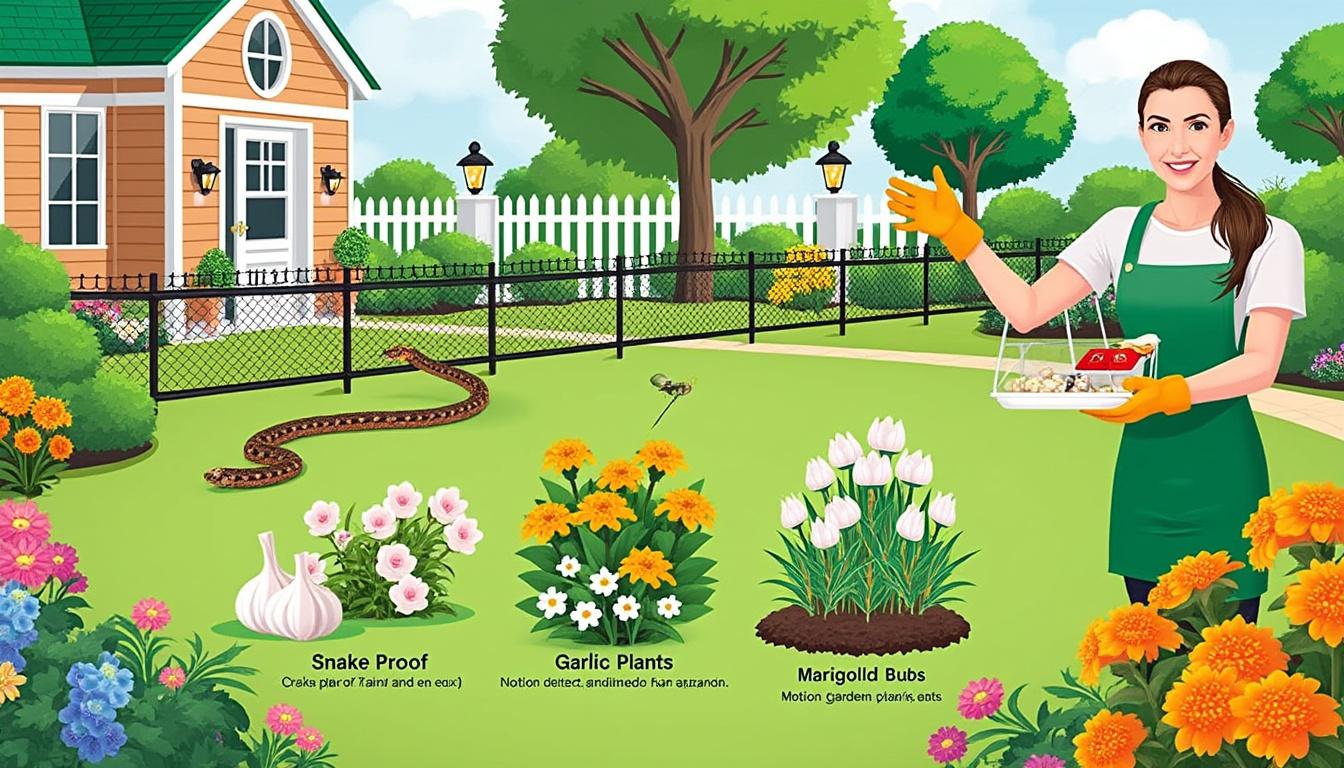Snakes, while essential to ecological balance, often stir unease when they occupy residential areas. These reptiles play a vital role by controlling pests such as rodents and insects, yet their presence near homes and gardens can prompt concerns for safety and comfort. A strategic approach to deterring snakes combines effective habitat management, the use of specialized repellents, and physical barriers that discourage these visitors without harming them or the environment. With the advancement of products like Ortho, Hot Shot, and Natural Guard, alongside traditional natural methods, homeowners have an array of tools to maintain snake-free surroundings.
Understanding snake behavior is critical for prevention. Snakes seek shelter, food, and water, often drawn to areas that provide cover and attract prey. This makes untamed gardens, wood piles, and cluttered backyards prime spots for snake habitation. Employing expert guidance on habitat modification, applying reputable repellents such as Snake Away and Bonide, and establishing routine maintenance can significantly reduce the likelihood of snake encounters. This compendium of techniques and insights empowers homeowners to create secure environments while respecting the ecological importance of snakes.
Optimizing Your Home Environment To Deter Snakes Effectively
Creating a home environment that naturally discourages snakes begins with making the property less appealing and accessible to them. Since snakes look for hiding spots and food sources, eliminating these elements from your surroundings is paramount.
Simple adjustments in landscaping and routine upkeep can yield noticeable results. For instance, keeping grass trimmed short reduces cover, thus exposing snakes and limiting safe zones. Removing piles of debris, wood, or rocks deprives snakes of shelter. Additionally, sealing cracks and openings around the foundation blocks entry points significantly.
Key Strategies To Reduce Attractants
- Maintain Short Lawns: Regular mowing suppresses overgrowth where snakes harbour.
- Clear Garden Clutter: Eliminate leaf piles, stone heaps, and woodpiles that serve as natural cover.
- Seal Entry Points: Use caulking or weatherstripping to close gaps in foundations, doors, and windows.
- Pet Food Storage: Ensure pet food is stored indoors to prevent attracting rodents, which in turn attract snakes.
- Control Rodents: Use safe trapping or bait stations to limit prey availability.
Homeowners can complement these actions with commercially available snake repellents such as Ortho and Hot Shot. These products often contain ingredients that create an unwelcoming scent or irritation for snakes, prompting them to vacate the area. For example, Ortho’s formula may include sulfur compounds that snakes instinctively avoid. It is important to follow product instructions carefully to ensure safety, particularly around children and pets.
Expert Table On Home Environment Features And Their Impact
| Home Feature | Effect On Snake Presence | Recommended Action | Products To Use |
|---|---|---|---|
| Long Grass and Overgrowth | Offers concealment | Regular mowing and trimming | Ortho Lawn Care Products |
| Accumulated Debris | Provides shelter | Clear piles and store wood off-ground | Manual removal, Natural Guard |
| Foundation Cracks | Entry points for snakes | Seal with caulk or weatherstripping | Home sealants |
| Rodent Presence | Prey source for snakes | Use traps or deterrents | Victor Traps, Terro Bait Stations |
Utilizing Proven Snake Repellents And Natural Guards For Gardens
Gardens require specialized care as they inherently attract snakes due to plant cover and ample food sources. Employing both natural and chemical repellents can achieve sustained snake deterrence without harming the beneficial aspects of the garden ecosystem.
Natural repellent plants, such as marigolds, wormwood, and lemongrass, emit odors that snakes find unpleasant. These plants, in combination with commercial repellents like Snake Away and Bonide, create layers of deterrence. Bonide’s products, often including essential oils as active ingredients, blend efficacy with environmental consciousness.
Effective Natural And Chemical Repellents
- Plant Snake-Repellent Vegetation: Incorporate marigolds, and alliums in garden borders.
- Apply Repellent Granules: Use Snake Away granules around garden perimeters.
- Use Spray Repellents: Bonide’s spray forms offer quick coverage after rain or watering.
- Maintain Dry Soil: Overwatering attracts prey and snakes; adjust accordingly.
- Rotate Repellents: Alternating products prevents snakes from acclimating.
Homeowners should be cautious to apply repellents on dry days and follow label directions for optimal results. Reapplication frequency varies but is typically every 1-2 weeks, particularly in areas with frequent rainfall. Pairing repellents with habitat modification enhances long-term outcomes.
Comparative Table Of Popular Snake Repellent Products
| Product Name | Type | Primary Ingredients | Best Use Case | Pet Safety |
|---|---|---|---|---|
| Snake Away | Granules | Essential oils (cinnamon, clove) | Garden perimeters, lawns | High |
| Bonide Snake Repellent | Spray | Essential oils blend | Vegetation and shrub roots | Moderate to high |
| Natural Guard Snake Repellent | Granules | Ingredients of natural origin | Around foundations and flower beds | High |
| Liquid Fence | Spray | Plant-based ingredients | Large garden areas, walkways | High |
Installing Physical Barriers To Prevent Snake Intrusion In Gardens And Homes
Physical barriers serve as a concrete method of preventing snake access to critical areas. Installing fences, mesh, or sealing off spaces effectively limits the chances of snakes infiltrating homes or garden spaces.
Snake-proof fencing is a leading solution, typically made from fine mesh wire buried a few inches underground to prevent snakes from burrowing under. Height is also a factor; fences at least 3 feet tall with an outward slant discourage climbing. For foundations and crawl spaces, sealing vents and gaps with hardware cloth or caulk eliminates entryways.
Key Materials And Installation Practices For Effective Barriers
- Fine Mesh Fencing: Use hardware cloth with ¼ inch or smaller mesh size.
- Bury Fence Edges: Embed fencing 6-12 inches underground to prevent undercutting.
- Fence Height And Slant: Construct fences at minimum 3 feet tall with a 10-15 degree outward angle.
- Seal Foundation Vents: Use metal mesh covers and seal edges to close openings.
- Install Door Sweeps: Prevent snakes entering under doors with tightly sealed sweeps.
Apart from physical structures, combining these barriers with deterrents like Victor traps and repellents increases efficacy. While traps focus on humane removal, barriers act as permanent structures reducing the need for frequent interventions.
Table Of Barrier Types And Applications
| Barrier Type | Application Area | Material Specs | Installation Tips | Longevity |
|---|---|---|---|---|
| Fine Mesh Fence | Garden perimeter | Hardware cloth, ¼ inch mesh | Bury edges 6-12 inches, 3ft height, slant outward | 5-10 years |
| Foundation Vents | Home crawl spaces | Metal mesh covers | Seal all openings carefully | Indefinite if maintained |
| Door Sweeps | Entry doors | Rubber or metal strip | Install flush to eliminate gaps | 2-5 years |
Natural Remedies And Safe Practices Using Eco-friendly Products And Pet Safe Solutions
Many homeowners prefer natural and eco-friendly approaches to snake deterrence due to concerns about chemicals and pet safety. Products like Terro and Liquid Fence offer plant-based options that align with environmentally conscious gardening.
Natural remedies such as essential oils including cedarwood, clove, and cinnamon mixed in sprays have shown effectiveness in repelling snakes without toxic effects. Maintaining dry soil conditions and removing standing water reduces snake attraction since many prey animals seek moist environments.
Practical Natural Techniques To Minimize Snake Encroachment
- Essential Oil Sprays: Mix oils like cinnamon and clove with water and spray perimeter areas.
- Use Granular Natural Repellents: Apply products containing natural ingredients like Liquid Fence granules.
- Eliminate Moisture: Fix leaks, avoid overwatering, and improve drainage.
- Encourage Predators: Attract birds of prey or install owl boxes to naturally control snake populations.
- Regular Cleaning: Keep outdoor spaces tidy and minimize hiding spots.
Using pet safe formulations from brands such as Natural Guard and Liquid Fence ensures that children and pets remain unharmed. Always review product labels for safety and reapply treatments following manufacturer recommendations.
Table Comparing Chemical vs Natural Snake Deterrents
| Approach | Effectiveness | Environmental Impact | Pet Safety Level | Cost Range |
|---|---|---|---|---|
| Chemical Repellents (Ortho, Hot Shot) | High | Moderate | Moderate | $$ |
| Natural Repellents (Liquid Fence, Snake Away) | Moderate to High | Low | High | $$$ |
| Physical Barriers | Very High | None | High | $$$ |
Frequently Asked Questions On How To Keep Snakes Away From Home And Garden
- What is the most effective snake repellent for home use?
Physical barriers combined with repellents like Snake Away or Bonide offer strong protection. Regular maintenance and habitat control are equally essential.
- Are natural repellents safe for pets and children?
Products such as Natural Guard and Liquid Fence are formulated to be pet safe, but care should still be taken to follow application instructions properly.
- How often should snake repellents be applied?
Typically, repellents must be reapplied every 1-2 weeks, especially after rain, to maintain efficacy.
- Can I prevent snakes by sealing my home alone?
Sealing entry points dramatically decreases indoor encounters but may not deter snakes from the garden or yard without additional measures.
- Is trapping snakes a humane solution?
Humane traps like those from Victor allow safe removal and relocation, which is preferable to lethal methods for maintaining local ecosystems.

